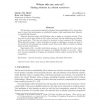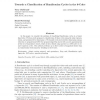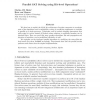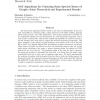73
Voted
JSAT
2008
15 years 20 days ago
2008
89
Voted
JSAT
2008
15 years 20 days ago
2008
We introduce a new jump strategy for look-ahead based satisfiability (Sat) solvers that aims to boost their performance on satisfiable formulae, while maintaining their behavior o...
109
click to vote
JSAT
2008
15 years 20 days ago
2008
In this paper, we consider the problem of classifying Hamiltonian cycles in a binary hypercube. Previous work proposed a classification of these cycles using the edge representati...
109
Voted
JSAT
2008
15 years 20 days ago
2008
We describe the organization and report on the results of the First and Second Max-SAT Evaluations, which were organized as affiliated events of the 2006 and 2007 editions of the ...
90
Voted
JSAT
2008
15 years 20 days ago
2008
We show how to exploit the 32/64 bit architecture of modern computers to accelerate some of the algorithms used in satisfiability solving by modifying assignments to variables in ...
97
Voted
JSAT
2008
15 years 20 days ago
2008
In this article we describe and evaluate optimized compact data structures for watching literals. Experiments with our SAT solver PicoSAT show that this low-level optimization not...
120
click to vote
JSAT
2008
15 years 20 days ago
2008
The local search algorithm GSAT is based on the notion of Satisfiability. It has been used successfully for colouring graphs, solving instances of the 3SAT problem, planning block...
106
Voted
JSAT
2008
15 years 20 days ago
2008
We analyze, in this work, the performance of a recently introduced weighted Max-SAT solver, Clone, in the Max-SAT evaluation 2007. Clone utilizes a novel bound computation based o...
106
click to vote
JSAT
2008
15 years 20 days ago
2008
This paper proposes a new semidefinite programming relaxation for the satisfiability problem. This relaxation is an extension of previous relaxations arising from the paradigm of ...
JSAT
2008
15 years 20 days ago
2008
We propose a new switching criterion, namely the evenness or unevenness of the distribution of variable weights, and use this criterion to combine intensification and diversificat...




